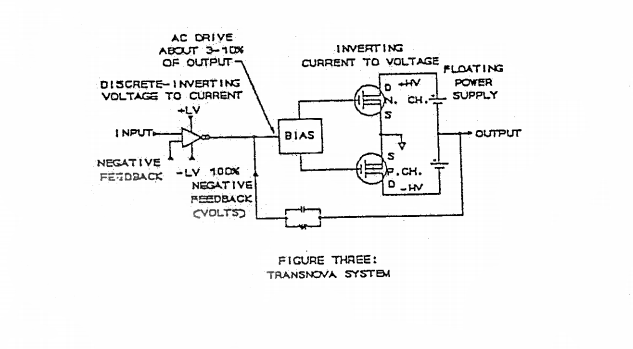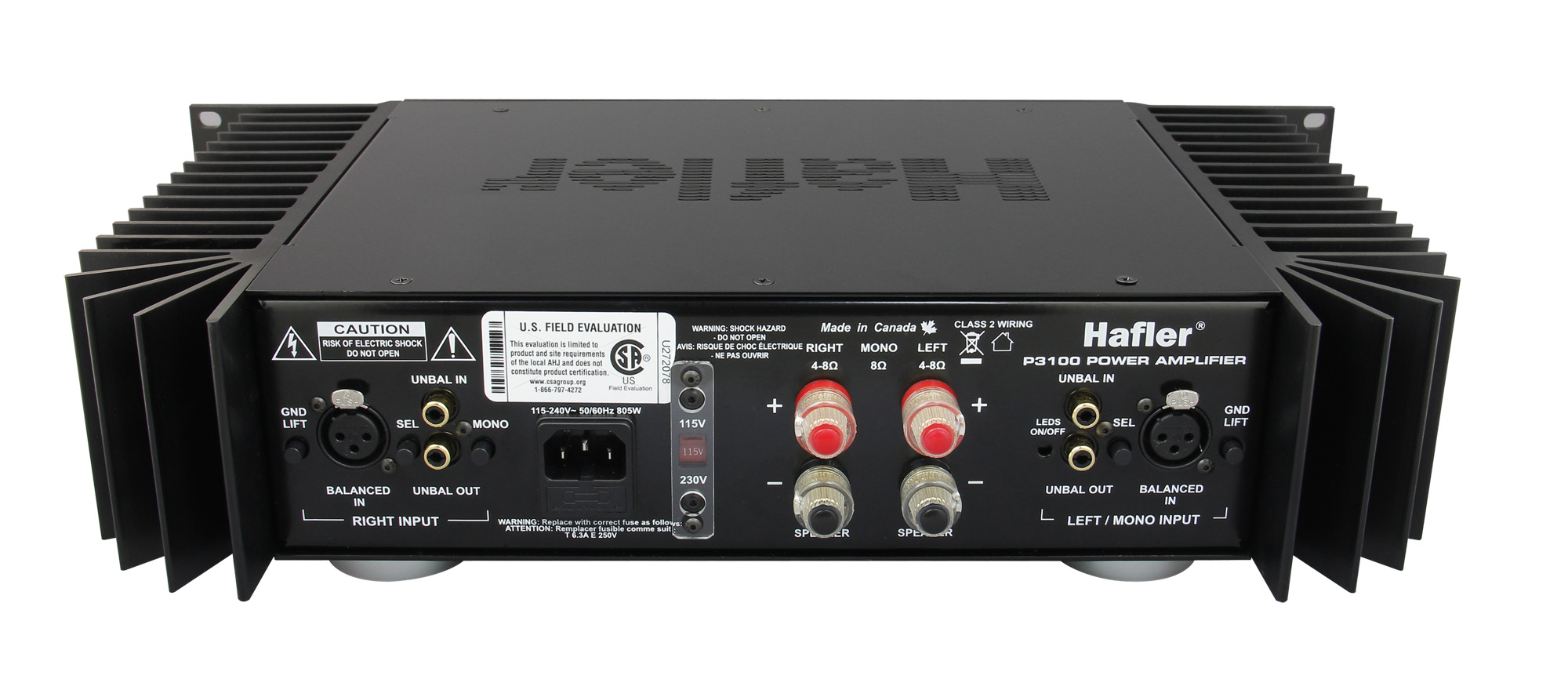For almost 20 years now, I’ve used the discontinued Hafler P3000 amplifier to power my Yamaha NS10M Studio and DAS Monitor-8 passive nearfields, nervously watching suitable replacement amps exit the market as active monitors became de rigueur. So I was thrilled when Radial Engineering bought the dormant Hafler brand in 2014 and soon thereafter announced the Hafler P3100.
Transcendent
The 2-channel P3100 uses a refined version of Hafler’s patented Trans•Nova (TRANSconductance Nodal Voltage Amplifier) circuitry. Employing high-speed lateral MOSFETs at the amp’s outputs, this design reduces the audio path—employing only three gain stages—and removes the need for elaborate protection schemes that would otherwise degrade the amp’s pristine sound.

The circuit’s latest iteration uses a toroidal transformer, resulting in tighter bass-band reproduction and less potential for induced noise from external electrical sources compared to when using a conventional E-lam transformer. According to Hafler’s design engineer, the amp’s unusually high biasing assures very clean low-level sound—especially important for mixing and mastering work. The amp runs pure Class-A up to about 5 watts and Class-AB at higher levels.
Like the P3000, the P3100 can drive a pair of monitors with 150 watts RMS per channel into 8 ohms or 200 watts RMS into 4 ohms; alternatively, you can bridge the amp’s two output channels for 400 watts RMS of mono power to drive a subwoofer or—using two P3100s—two large monitors having at least 8 ohms impedance.
The P3100 needn’t be placed in an iso or closet: 34 oversized heatsinks (identical to those used in the legacy P3000) flank the amp’s sides and provide passive convection cooling that, along with vented top and bottom chassis, eliminate the need for an internal fan. Four sturdy feet—2 inches in diameter and a half-inch tall—provide ventilating clearance for the bottom chassis with tabletop installation; they can be removed to snugly rackmount the 2RU amp. Like the P3000, the P3100 weighs 23 pounds.
Related: Three for Listening: Grace Design m900, Hafler HA75-DAC TubeHead, Stealth Sonics C9 IEMs, by Kevin Becka, Jan. 31, 2018
On the P3100’s beautiful front panel, a sturdy, rocker-style soft-start (time-delayed) power switch protects monitors from damaging pops and thumps when powering up. Two continuously variable rotary knobs let you independently adjust (from +14 to +29 dB) respective gain for left and right channels, which is critical in asymmetrical rooms that reinforce one monitor over another.
Metering has been greatly improved over the P3000, which would be expected after 20 years: Multicolored ballistic LEDs (11 per channel) show levels, idle status (powered up, but no signal present) and clipping at the P3100’s outputs. Two other LEDs (legacy holdovers) light up if an electrical fault or excessive heat is detected, in which case the P3100 will automatically shut down.

All connections are made on the P3100’s rear panel. Each channel provides a balanced XLR line input, with a ground lift switch that disconnects Pin 1 when engaged; two RCA jacks for unbalanced line-level I/O (the output runs parallel to the input and can be used to send the source signal to another destination); a switch that selects which input to use; and gold-plated binding posts for wiring the amp’s speaker outputs to your monitors, accommodating any cable size up to 6AWG. I was disappointed to find that the XLR/TRS combo jack shown on prototypes was replaced by a less-adaptable XLR.
Engaging a mono switch feeds both speaker outputs from the left channel, for bridged operation. Another switch allows 115V or 230V operation worldwide and features a security cover to prevent accidental adjustment. Yet another switch, this one suitably recessed, disables the LED level indicators on the front panel. An IEC power receptacle accepts the included 14-gauge (beefy!), grounded, 6-foot AC cable. The P3100 has a three-year warranty.
Audio Performance
The P3100’s full-power bandwidth is cited to be 0.15 Hz to 300 kHz (+0/-3 dB). THD is less than 0.01 percent from 1 watt to 85 percent of rated power, and signal-to-noise is said to be 102 dBA—significant improvements over the legacy P3000’s specs. Other specs match those for the P3000: The slew rate—in practical terms, an indicator of how fast the amp will respond to transients—is an impressive 100 volts per microsecond. The damping factor (the ability of the amp to control unwanted motion in a speaker cone at its resonant frequency, most important in the bass range) is also very impressive: 400 up to 1 kHz, 200 between 1 and 10 kHz, and 18 from 10 to 100 kHz. To get the best sonic performance from your P3100, it is recommended that you let it warm up for an hour before critical use.
Want more stories like this? Subscribe to our newsletter and get it delivered right to your inbox.
Quiet when idling, the P3100 provided my nearfields with plenty of clean power—in fact, way more than was needed to listen at reasonable levels. In my recording and critical listening sessions, the P3100 subjectively had the same essential sound—open, natural and unrestrained—as its discontinued predecessor, the P3000. The amp’s spectral balance sounded honest, with clear midrange reproduction and smooth highs that allowed many hours of listening without fatigue.
Low frequencies sounded very focused, a hallmark of the Hafler Trans•Nova sound; listening with the P3100, you likely won’t be making misguided adjustments to tighten up kick drum and bass guitar tracks that don’t need them. Transient reproduction was superb—extremely detailed, yet not harsh—no doubt due to the P3100’s exceptional slew rate. Using an amp like the P3100 that responds so quickly to drum hits and string plucks, you’re less likely to reach for transient shapers and high-frequency EQ boost when they’re not needed. The P3100’s stereo imaging and depth of field were also both excellent, allowing accurate pan adjustments and creating an enjoyable, immersive experience.
In summary, the P3100 is an all-around excellent studio power amp. If, like me, you’re a fan of Hafler Trans•Nova amps’ highly detailed sound and tight low end, you’ll love the new P3100.
Michael Cooper ([email protected]) is a recording, mix, mastering and post-production engineer and a contributing editor for Mix magazine.
Product Summary
Company: Hafler
Product: P3100
Website: www.hafler.com
Price: $2,000
Pros: Very open, balanced and natural sound. Yields impressively tight lows and transient detail. Passive cooling (no noisy fan). Multi-segment level meters and fault indicators.
Cons: No TRS inputs.







